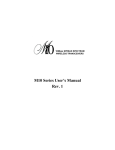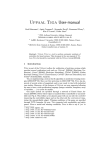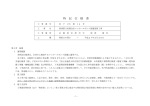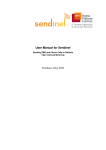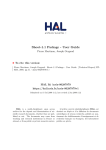Download Link Layer Protocol Simulator User Guide - HAL
Transcript
Link Layer Protocol Simulator User Guide
Emmanuel Nataf
To cite this version:
Emmanuel Nataf. Link Layer Protocol Simulator User Guide. [Technical Report] 2008, pp.15.
<inria-00205027v1>
HAL Id: inria-00205027
https://hal.inria.fr/inria-00205027v1
Submitted on 16 Jan 2008 (v1), last revised 17 Jan 2008 (v2)
HAL is a multi-disciplinary open access
archive for the deposit and dissemination of scientific research documents, whether they are published or not. The documents may come from
teaching and research institutions in France or
abroad, or from public or private research centers.
L’archive ouverte pluridisciplinaire HAL, est
destin´ee au d´epˆot et `a la diffusion de documents
scientifiques de niveau recherche, publi´es ou non,
´emanant des ´etablissements d’enseignement et de
recherche fran¸cais ou ´etrangers, des laboratoires
publics ou priv´es.
INSTITUT NATIONAL DE RECHERCHE EN INFORMATIQUE ET EN AUTOMATIQUE
Data Link Layer Protocol Simulator
User guide
Emmanuel Nataf
N° ????
Janvier 2008
ISSN 0249-0803
apport
technique
ISRN INRIA/RT--????--FR+ENG
Thème COM
Data Link Layer Protocol Simulator
User guide
Emmanuel Nataf∗
Th`eme COM — Syst`emes communicants
´
Equipe-Projet
Madynes
Rapport technique n ???? — Janvier 2008 — 15 pages
Abstract: The data link layer protocol simulator allows to write protocol and
to see them in execution. This guide describes a step by step approach from
simple information communication without any control to windows protocols.
A protocol oriented java API is defined to write protocol algorithms.
Key-words: network, protocol, data link, simulator, java
∗
Maˆıtre de conf´erence - Universit´e Nancy2
Centre de recherche INRIA Nancy – Grand Est
LORIA, Technopôle de Nancy-Brabois, Campus scientifique,
615, rue du Jardin Botanique, BP 101, 54602 Villers-Lès-Nancy
Téléphone : +33 3 83 59 30 00 — Télécopie : +33 3 83 27 83 19
Simulateur de Protocoles de la Couche Liaison
de Donn´
ees
R´
esum´
e : Le simulateur de protocoles de la couche liaison de donn´ee permet
de programmer des protocoles et de les voir s’animer afin de les tester. Ce
guide d´ecrit une progression p´edagogique allant du transfert d’information sans
contrˆ
ole aux protocoles fenˆetres. Une interface de programmation java est dfinie
afin de permettre l’criture des algorithmes des protocoles.
Mots-cl´
es : r´eseau, protocole, liaison de donn´ee, simulateur, java
3
Data Link Layer Protocol Simulator user guide
1
Introduction
Data link protocols are used to transmit data between two network nodes (computers, switches, router, . . . ). In the following we consider one data sender node
and one data receiver node. In between there is the network with this statement:
Any data sended to the network could be lost.
Data link protocols are created to work against this hypothesis. They should
ensure that :
1. receiver has well receive all data sended;
2. sender is acknowledged of data reception.
In the following, we will start from simple data transmission without any
control until complex protocols that encompass theses constraints.
1.1
Simulator use
The simulator is written with java language and the simullc.jar file contains
all needed classes, especially graphical ones.
There are two java files for each protocol, one is called SenderNameOfTheProtocol.java and the other ReceiverNameOfTheProtocol.java (ex. SenderNoProtocol.java). Sender and Receiver protocols are implemented in these
files. In order to test sender and receiver they need to be compiled with the
graphical interface (one can use the files compile.bat or compile.sh. To launch
simulation one should use the file launch.bat or launch.sh like :
launch <ProtocolName> [-m "sended message" ] [-d timeout in second]
[-b window size]
for example
launch AnticipationWindow -m "anticipation window"
-d 15 -b 12
<ProtocolName> should be :
NoProtocol
BitAlternate
StopAndWait
SlidingWindow
AnticipationWindow
Other arguments are optional and default values are defined (“Test Message”,
10 s. timeout and a window size of 8 trames). Timeout and window parameters
are unusable for NoProtocol and BitAlternate. The window size is only used
in SlidingWindow and AnticipationWindow. Window size is necessary an even
number (the simulator adjust if an odd number is given).
At execution time, the simulator shows the following panel :
RT n 0123456789
4
E. Nataf
Sender and receiver start once the Go button is pressed. Frames are visualized
on the link between hosts. An animation moves frame from Sender to Receiver.
Any frame could be lost by the network. One can lost a frame with one mouse
click on a moving frame that will clear it.
2
No protocol link
This first protocol only sends and receives one message without take care of
frame lost. The figure 1 shows that a message is sended char by char. At
the end of the message a dedicated char : # is added to signal the end of the
transmission.
INRIA
5
Data Link Layer Protocol Simulator user guide
Sender
e
#
g
a
Receiver
s
s
e
M
#
e
g
a
Data sended : Message
Emetteur
Data sended : Message
Receiver
Data received : Mess
Figure 1: No Protocol link
2.1
Java API
In order to write this simple message transmission inside the simulator the following API must be used :
Frame readData()
void sendFrame(Frame t)
Frame receiveFrame()
char getData(Frame)
void writeData(Frame)
void display(String mes)
2.2
Each call of this method create a Frame instance with one char inside. The method
manages an internal pointer to read the
message from the first char to the last.
When the end of the message is reached,
any call of this methode creates a Frame
with the # char inside.
Send the Frame on the wire.
Stop the calling thread until a Frame is
received. This method return the received
Frame.
Return the char inside the Frame.
Print the char inside the Frame on the simulator panel. The printing position is automatically incremented and there is no erasing. This method is used to show which
data are sended or received.
Print an information message under the
writeData printing (police size and color
are different). When called several times,
the last display call clear the string of the
preceding display call.
Exercice
Write sender and receiver protocol with this API and SenderNoProtocol, ReceiverNoProtocol java files. The sender must write any data sended but the
last # and display an end of transmission message. The receiver must write any
data received and also display an end of transmission message.
RT n 0123456789
6
E. Nataf
3
Bit Alternate Protocol
With the lack of control of the precedent exercice, any frame could be lost
without detection from the sender or the receiver. The Bit Alternate protocol
adds an extra information inside each frame. This information is either the 0
or 1 value. The figure 2 shows an example of message transmission.
Figure 2: Bit Alternate Protocol
3.1
Java API
New methods are needed to write the Bit Alternate protocol :
void markFrame(Frame t, int b)
int extractFrameNumber(Frame t)
3.2
Set the integer parameter inside the
Frame.
Extract the integer from the given
Frame.
Exercices :
1. Write sender and receiver for the Bit Alternate protocol. Receiver must
signal any lost of frame.
2. In which case frames could be lost without receiver detection ? How
improve such issue ?
3. One need to have messages with the # inside.
(a) What is the trouble ?
(b) Use the escape char \1 that will be added before sending the frame
with the # when this is not the end of the message. The sender could
use the following method :
boolean isEnded() return true if the last char of the
message has been already read.
The sender should print any data sended (escape char also) and the
receiver will only print chars of the initial message (without escape
char).
(c) Test with following messages :
One # inside
#box#
One \ inside
the \# = end
The end ?\#
1 Be
careful that the \ char has an interpretation too in java
INRIA
7
Data Link Layer Protocol Simulator user guide
(d) What could happen if a frame with the escape char is lost ?
4
Stop And Wait Protocol
The Stop And Wait protocol is safe because each time the sender sends a frame
it waits for an acknowledge frame from the receiver. The receiver must sends
such acknowledge frame for each received frame. It also uses the bit alternate
protocol.
The figure 3 details some steps of this protocol. The sender waits after
sending ’M’ frame. The receiver sends an acknowledge frame with the ’A’ char
when it receives the ’M’. The number of the frame and its acknowledge frame
must be the same.
Sender
Receiver
0 M
Data sended : M
Sender watiting ACK 0
Sender
Receiver
0 A
Data Sended : M
Data received : M
Sender waiting ACK 0
Next expected frame : 1
Sender
Receiver
1 e
Data sended : Me
Sender waiting ACK 1
Données reçues : M
Next expected frame : 1
Figure 3: Stop and Wait Protocol
The frame number is usefull when a frame is lost. The figure 4 shows all
possibilities (from a to g) . First, if the sended frame is lost, the sender will send
again the same frame after a while. Such event is generally called a TIMEOUT.
If the acknowledge frame is lost then the sender sends again the frame and the
receiver must return an acknowledge but not accept the frame as part of the
message because it knows that it has already received the frame thanks to the
frame number.
4.1
Java API
There is a Frame constructor need for the receiver API :
RT n 0123456789
8
E. Nataf
(a)
Sender
(d)
Receiver
Sender
0 M
Receiver
0 A
Data received : M
Data sended : M
Data sended : MM
Sender waiting ACK 0
Sender waiting ACK 0
(b)
Sender
(e)
Receiver
Sender
Receiver
Data received : M
Data sended : M
Data sended : MM
Sender pending ACK 0
Sender waiting ACK 0
TIMEOUT
TIMEOUT
(c)
Sender
Next expected frame : 1
Next expected frame : 1
(f)
Receiver
Sender
0 M
Receiver
0 M
Data received : M
Data sended : MM
Data sended : MMM
Sender waiting ACK 0
Sender waiting ACK 0 Next expected frame : 1
(g)
Sender
Receiver
0 A
Data received : M
Data sended : MMM
Next expected frame : 1
but 0 received
Sender waiting ACK 0
Send ACK 0
Figure 4: Stop and Wait protocol and frame lost
INRIA
Data Link Layer Protocol Simulator user guide
Frame Frame(char data)
9
To create an acknowledge frame (usually with
the ’A’ char inside).
There is a new method for the sender API :
Frame receiveFrame(int delay)
Stop the calling thread until a frame is
received or the delay time is reached.
The delay is a number of seconds (or
use the delay attribute).
The use of this method is twofold because either the frame is received before
delay time either it is not. The way to use this method is the following :
try{
Frame t = receiveFrame(delay);
//... frame is received before delay seconds
}catch(TimeoutException t){
// ... no frame is received after delay seconds
}
4.2
Exercice :
1. Write the Stop And Wait protocol. Sender should print information if
timeout occurs and receiver should display an error message when it receives a frame without the expected frame number.
2. What will happen if the network is broken (any frame are received)? Program the sender in order to prevent an infinite loop of send and timeout.
5
Sliding window protocol
A limitation of the Stop And Wait protocol is waiting time after each sended
frame, especially if transmission are on long link. The main principle of the Sliding Window protocol is to send several frames and, after, wait their acknowledge.
An example on the figure 5 shows the interest of this protocol. Sender sends
several frames and starts waiting each time. The receiver sends an acknowledge
frame for any received frame. The network bandwith is better used and the
message transmission time faster than with the Stop And Wait Protocol.
What are the differences of this protocol between the Stop and Wait? First,
it needs to have more than one bit to count frames and second, it needs to
store each frame that are sended but no yet acknowledged. This is to be able
to send again a lost frame (or its acknowledge). In the following we use eight
values (from 0 to 7, see figure 6) to count frames. A circular buffer is used to
store sended frames and when this buffer is full, the sender should wait before
sended more frames. The receiver should ackwoldege each received frame with
the same frame number. This acknowledge allows the sender to release a slot
RT n 0123456789
10
E. Nataf
Sender
Receiver
2 s
1 e
0 M
0 A
1 A
2 A
5 g
4 a
3 s
Data sended Mes
Sender waiting ACK 0
Sender waiting ACK 1
Sender waiting ACK 2
Sender
Receiver
Data sended Messag
Sender waiting ACK 0
Data received Mes
Sender waiting ACK 1
Next expected frame : 3
Sender waiting ACK 2
Sender waiting ACK 3
Sender waiting ACK 4
Sender waiting ACK 5
Figure 5: Protocole Sliding Window
in its circular buffer. So it could send one other new frame. The receiver must
acknowledge any frame but must only accept the expected frame and so it must
know the sender buffer size and the starting frame number.
6
n
6
7 r
M
i
e
g
s
5
a
s
4
3
7
0
n
i
4
6 e
5 g
g
Receiver
3 s
4 a
Data received : Mes
2
Next frame number expected : 3
3 A
4 A
0 g
5 A
Receiver
7 n
6 i
1
Data sended : Messaging#
2
s
2 A
Data sended : Messagin
1 #
g
a
1 A
1
Sender
#
5
0 A
Sender
0
7
Data received : Messag
Next frame number expected : 6
3
Figure 6: Circular buffer of the Sliding Window protocol
This protocol il safe against frame lost as the Stop And Wait protocol. A
frame lost leads to a timeout and so sending of the same frame. An acknowledge
INRIA
11
Data Link Layer Protocol Simulator user guide
lost will do the same and, as the receiver knows which frame number it waits,
there will be not possible to have two identical frames accepted.
However if the sender use all its buffer slots then the lost of the last acknowledge leads to a mistake. The figure 7.a shows such a case. As it was
not acknowledged the sender send again this frame (7.b). When it comes to
the receiver it will accept it as it care the good number 0 and finally displays
the message ”MessaginM”. A solution to avoid it will be to not full the sender
buffer but have always at least one free slot.
(a)
n
6
Sender
0
7
7 n
M
i
e
g
s
5
a
s
4
0 A
6 i
1 A
5 g
2 A
4 a
Receiver
3 s
1
Data received : Mes
Data sended : Messagin
2
Next expected frame : 3
3
(b)
n
6
0 M
M
i
e
g
s
5
a
4
Receiver
Sender
0
7
s
1
Data received : Messagin
2
Data sended : Messagin
Next expected frame : 0
3
TIMEOUT frame number 0
Figure 7: Sliding Window protocol limitation
5.1
Java API
A Buffer class is needed to program the Sliding Window protocol. The figure
8 shows that a Buffer has two pointers b inf and b sup (for the inferior and
superior bounds). Copies of sended but not yet acknowledged frames are stored
in the buffer from the b inf position and a copy of the next new frame to send
will be put at the b sup position. In the figure the buffer starts from an initial
state to the sending of two frames and the reception of their acknowledge.
Following methods are to use with the buffer (there is no need to explicitely
create a Buffer as there is already one in the Sender class) :
RT n 0123456789
12
E. Nataf
b_inf
b_inf b_sup
7
7
0
1
6
4
e
2
5
3
7
1
M
6
2
5
0
4
0
6
1
5
2
b_inf
b_sup
3
4
3
Figure 8: Operation on buffer
int getInf()
int getSup()
void incInf()
void incSup()
void receiveFrame(int delay, Frame t)
Frame getFrameAt(int i)
void ackFrame(int i)
void putFrameAt(Frame t, int i)
void waitFreePlaces(int i)
Return the inferior bound of
the Buffer.
Return the superior bound
of the Buffer.
Add one to b inf modulo the
Buffer size.
Add one to b sup modulo
the Buffer size.
Stop the calling thread until an acknowledge Frame of
the given Frame is received
or if a timeout occurs (after
delay seconds).
Get the Frame at the given
position in the Buffer.
Remove the Frame at the
given position in the Buffer.
Put the Frame at the given
position in the Buffer.
Stop the calling thread until
there is at least as much free
buffer places than the given
integer.
Inside the simulator a class called Acknowledge should be used to wait the
reception of an acknowledge. An instance of this class is automatically created
each time the SendFrame(Frame t) method is used2 . At one time there could
be several instances of this class around one buffer instance. Concurrent access
is managed by the buffer.
5.2
Exercice :
1. Write sender and receiver for the Sliding Window protocol. There are two
parts in the sender. One is for sending frames and filling the buffer and
2 this
method has been overloaded in order to do so
INRIA
b_sup
13
Data Link Layer Protocol Simulator user guide
the other one is for acknowledge reception. The receiver could use the
buffer size attribute.
2. Be sure two identical frames could not be accepted.
6
Anticipation Window Protocol
The Anticipation Window protocol improves the Slinding Window. It allows
the receiver to accepts frames that are not exactly the next one expected. If
one frame is lost but not the following then it will be more efficient to store
these following frames pending the sender sends the missing one.
The figure 9 shows an example of such protocol. As in the Sliding Window,
the sender sends several frames and stores a copy of each one in its buffer.
However the receiver is not waiting for one frame but for any frame with a
number from 0 to 7. It is why the receiver also must have one circulary buffer
of the same size than the sender. In the top part of the figure three frames was
correctly received and so the receiver is waiting frames number 3 to 2. Suppose
now that the frame number 4 is lost. The bottom parts of the figure shows
0
7
n
6
M
i
e
g
s
5
a
s
4
6 i
1 A
2 A
5 g
4 a
Receiver
3 s
Data received : Mes
4
1 Sender
Receiver
1 #
0 g
2
a
e
4
7
3
6
7 n
2
1
i
2
5
Next expected frames : 4 to 3
1
3
0
g
Data received : Mess
Data sended : Messaging
s
5
Next expected frames : 3 to 2
#
M
6
2
Data sended : Messagin
g
0
7
0
n
5
0 A
7 n
3
7
6
1 Sender
4
3
7
0
TIMEOUT frame number 4
0
7
6
#
1 Sender
1 A
2 A
Receiver
6
4 a
5
4
3
Data sended : Messaginga
Data received : Mess
Next expected frames : 4 to 3
what going on. First the sender continues to send frames and release buffer
slots upon acknowledge receptions and second the receiver has accepted frames
after the number 4 but has kept them in its buffer as it has not received the
#
4
1
2
5
Figure 9: Protocole Anticipation Window
RT n 0123456789
g
g
2
a
n
i
3
14
E. Nataf
frame number 4. When this frame is sended again and (this time) received then
all the buffer frames from number 4 to 2 are emptied.
The figure 10 shows a case where a trouble occurs. If the acknowledge
number 4 is lost and the sender continues to send frames. The receiver reception
window moves from 5 to 4 waiting numbers to 4 to 3 wainting numbers. When
timeout occurs at the sender side it sends again the frame number 4 and the
receiver could not know that this frame was identical with the previous frame
number 4. In order to solve this problem the sender should not send too much
0
7
6
7
M
n
i
e
g
s
5
a
s
4
1
Sender
0 A 1 A 2 A 3 A 4 A
7 n
2
6 i
6
1
5
2
5 g
Data received : Messa
Data sended : Messagin
3
Receiver
0
4
3
7
0
Next expected frames : 5 to 4
0
7
n
6
g
.
5
Receiver
1 .
0 g
2
a
4
1 Sender
6
1
5
2
7 n
Data received : Messagi
Data sended : Messaging.
3
Next expected frames : 7 to 6
4
3
7
0
TIMEOUT frame number 4
0
7
6
.
5
3
2 A
Receiver
Sender
6
1
5
2
4 a
2
a
4
1 A
1
Data sended : Messaging.a
Data received : Messaging
4
Next expecting frames : 4 to 3
Figure 10: Limite du Protocole Anticipation Window
frame in advance. Indeed when the sender has send frames after the number
4, the receiver has moved its reception window until overlaps the number 4.
If the sender has limited itself to not send more than three frames after the 4
then the receiver would not accept the second frame number 4 because it was
not inside waiting numbers (but just send an aknowledge to release the sender).
There will be no trouble if the sender stops its sending after has sended half of
the buffer size frames (not acknowedged) in order to not overlap sending and
reception windows.
6.1
Java API
Following methods are to be used to write the Anticipation Window protocol:
INRIA
3
15
Data Link Layer Protocol Simulator user guide
int getBufferSize()
boolean inWindow(int inf, int sup, int num)
6.2
Return the buffer
size.
Check if a frame
number is inside the
anticipation window.
Exercice :
1. Write the Anticipation Window protocol.
2. Write the safe version of the Anticipation Window protocol.
RT n 0123456789
Centre de recherche INRIA Nancy – Grand Est
LORIA, Technopôle de Nancy-Brabois - Campus scientifique
615, rue du Jardin Botanique - BP 101 - 54602 Villers-lès-Nancy Cedex (France)
Centre de recherche INRIA Bordeaux – Sud Ouest : Domaine Universitaire - 351, cours de la Libération - 33405 Talence Cedex
Centre de recherche INRIA Grenoble – Rhône-Alpes : 655, avenue de l’Europe - 38334 Montbonnot Saint-Ismier
Centre de recherche INRIA Lille – Nord Europe : Parc Scientifique de la Haute Borne - 40, avenue Halley - 59650 Villeneuve d’Ascq
Centre de recherche INRIA Paris – Rocquencourt : Domaine de Voluceau - Rocquencourt - BP 105 - 78153 Le Chesnay Cedex
Centre de recherche INRIA Rennes – Bretagne Atlantique : IRISA, Campus universitaire de Beaulieu - 35042 Rennes Cedex
Centre de recherche INRIA Saclay – Île-de-France : Parc Orsay Université - ZAC des Vignes : 4, rue Jacques Monod - 91893 Orsay Cedex
Centre de recherche INRIA Sophia Antipolis – Méditerranée : 2004, route des Lucioles - BP 93 - 06902 Sophia Antipolis Cedex
Éditeur
INRIA - Domaine de Voluceau - Rocquencourt, BP 105 - 78153 Le Chesnay Cedex (France)
ISSN 0249-0803



















